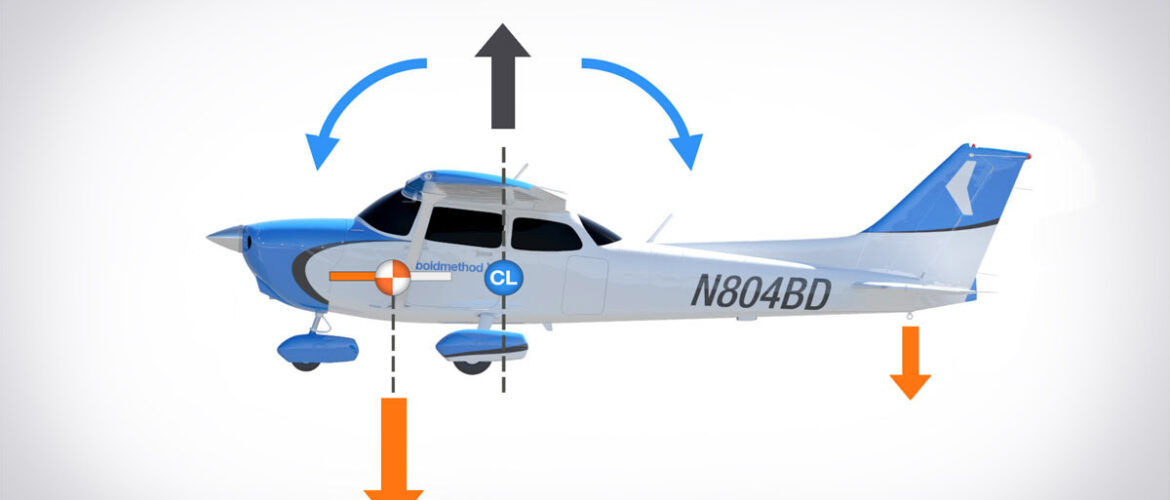Blog
Effects of Center of Gravity Location
- September 9, 2024
- Posted by: rsadmin_user
- Category: Education

The Key Variables
Three key variables influence cruise performance: the center of pressure, the center of gravity, and the downward force generated by the horizontal stabilizer (tail wing). The center of pressure is the point on the wing where lift is generated and is always located behind the center of gravity in conventional aircraft. The center of gravity is the point where the airplane’s weight is concentrated.
Visualizing with a Teeter-Totter
Imagine these variables as points on a teeter-totter: the center of pressure is the pivot point in the middle, while the center of gravity (C of G) and center of pressure (C of P) are at opposite ends. If one end of the teeter-totter is occupied by a heavy weight (e.g., a large person), balancing it requires an equally heavy weight on the other end. However, if you could shorten the length of one side of the teeter-totter (the side with the heavy weight), you would need a lighter weight on the opposite end to achieve balance. This is akin to having more leverage and requiring less force to maintain equilibrium.
Forward vs. Aft Center of Gravity
Adjusting the Center of Gravity
In an aircraft, adjusting the center of gravity can be compared to shortening one side of the teeter-totter. This adjustment is achieved by redistributing the load within the cabin, but it must be done within the designated center of gravity envelope.
Effects of Center of Gravity Location
When the center of gravity is positioned closer to the aft limit of the airplane, less downward force is required from the tail wing to keep the nose up. Since this downward force is essentially lift, less lift means less induced drag. As a result, with the center of gravity further aft, the aircraft needs less lift to maintain balance, leading to reduced induced drag and improved cruise performance. Conversely, a forward center of gravity requires more lift and therefore more induced drag, resulting in less efficient cruise performance.
Bonus Article Below:
Case Study: The Impact of Center of Gravity on Cruise Performance
Background:
In a recent operational analysis, a small twin-engine aircraft experienced fluctuating cruise performance. The flight data suggested that the aircraft’s cruise efficiency varied significantly between flights, leading to questions about the factors affecting performance.
Scenario:
On two separate flights, the aircraft’s center of gravity was adjusted to different positions within the allowable envelope:
- Flight A: Forward Center of Gravity
- Configuration: The aircraft’s load was positioned towards the front of the cabin, resulting in a center of gravity near the forward limit.
- Conditions: The aircraft was flown at a cruise altitude of 8,000 feet and a speed of 180 knots.
- Performance Data: The aircraft required increased engine power to maintain the desired speed. The observed fuel consumption was higher than expected, and the drag was noticeably greater.
- Flight B: Aft Center of Gravity
- Configuration: The load was redistributed towards the rear of the cabin, placing the center of gravity closer to the aft limit.
- Conditions: The same cruise altitude of 8,000 feet and speed of 180 knots were maintained.
- Performance Data: The aircraft required less engine power to sustain the same speed. Fuel consumption was lower, and drag was reduced compared to Flight A.
Analysis:
The difference in performance between the two flights can be attributed to the position of the center of gravity:
- Forward Center of Gravity (Flight A): The forward center of gravity increased the aerodynamic force required to keep the aircraft balanced. This resulted in greater lift generated by the wings and increased induced drag. Consequently, the aircraft needed more engine power to maintain speed, leading to higher fuel consumption.
- Aft Center of Gravity (Flight B): With the center of gravity closer to the aft limit, the aircraft required less lift to maintain balance, resulting in reduced induced drag. The decreased drag allowed for lower engine power settings and improved fuel efficiency.
Conclusion:
This case study demonstrates the significant impact that the center of gravity position can have on cruise performance. By adjusting the load distribution to position the center of gravity closer to the aft limit, the aircraft experienced improved efficiency, lower fuel consumption, and reduced drag. Pilots and operators should consider the center of gravity’s effect on performance when planning flights to optimize fuel efficiency and overall operational effectiveness.
